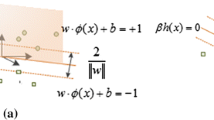Abstract
In this paper, one geometrical topology hypothesis is present based on the optimal cognition principle, and the single-hidden layer feedforward neural network with extreme learning machine (ELM) is used for 3D object recognition. It is shown that the proposed approach can identify the inherent distribution and the dependence structure for each 3D object along multiple view angles by evaluating the local topological segments with a dipole topology model and developing the relevant mathematical criterion with ELM algorithm. The ELM ensemble is then used to combine the individual single-hidden layer feedforward neural network of each 3D object for performance improvements. The simulation results have shown the excellent performance and the effectiveness of the developed scheme.




Similar content being viewed by others
Explore related subjects
Discover the latest articles, news and stories from top researchers in related subjects.References
Clark A (2001) Mindware: an introduction to the philosophy of cognitive science. Oxford University Press, New York
Shimshoni I, Ponce J (2000) Probabilistic 3D object recognition. Int J Comput Vis 36(1):51–70
Ma Y, Soatto S, Kosecka J, Sastry S (2003) An invitation to 3-D vision: from images to geometric models. Springer, New York
Pope AR, Lowe DG (2000) Probabilistic models of appearance for 3-D object recognition. Int J Comput Vis 40(2):149–167
Cyr CM, Kimia BB (2004) A similarity-based aspect-graph approach to 3D object recognition. Int J Comput Vis 57(1):5–22
Javed O, Shah M, Comaniciu D (2004) A probabilistic framework for object recognition in video. International Conference on Image Processing, Singapore
Fisher RA (1952) Contributions to mathematical statistics. Wiley, New York
Haykin S (1999) Neural networks: a comprehensive foundation. Prentice-Hall, New Jersey
Verleysen M, Voz JL, Thissen P, Legat JD (1995) A statistical neural network for high-dimensional vector classification. IEEE international conference on neural networks, ICNN’95, Perth, pp 990–994
Huang D-S (1996) Systematic theory of neural networks for pattern recognition. Publishing House of Electronic Industry of China, Beijing, pp 70–78
Nian R, Ji G-R, Zhao W-C, Feng C (2007) Probabilistic 3D object recognition from 2D invariant view sequence based on similarity. Neurocomputing 70(4–6):785–793
Vapnik VN (1995) The nature of statistical learning theory. Springer, Berlin
Xu L (2002) Bayesian Ying Yang harmony learning. In: Arbib MA (ed) The handbook of brain theory and neural networks. The MIT Press, Cambridge
Wang S-J (2003) Biomimetics pattern recognition. INNS, ENNS, JNNS Newletters Elseviers
Nian R, Ji G-R, Zhao W-C, Feng C (2005) ANN hybrid ensemble learning strategy in 3D object recognition and pose estimation based on similarity. Advances in Intelligent Computing, LNCS 3644, ICIC, part 1, pp 650–660
Huang G-B, Zhu Q-Y, Siew C-K (2006) Extreme learning machine: theory and applications. Neurocomputing 70:489–501
Huang G-B, Ding X, Zhou H (2010) Optimization method based extreme learning machine for classification. Neurocomputing 74:155–163
Man ZH, Lee K, Wang DH, Cao ZW, Miao CY (2011) A modified ELM algorithm for single-hidden layer feedforward neural networks with linear nodes. 2011 6th IEEE conference on industrial electronics and applications (ICIEA), pp 2524–2529
Miche Y, Sorjamaa A, Bas P, Simula O, Jutten C, Lendasse A (2010) Optimally-pruned extreme learning machine. IEEE Trans Neural Netw 21:158–162
Huang G-B (2003) Learning capability and storage capacity of two hidden-layer feedforward networks. IEEE Trans Neural Netw 14(2):274–281
Verleysen M (2003) Learning high-dimensional data. In: Ablameyko S et al (eds) Limitations and future trends in neural computation. IOS Press, Amsterdam, pp 141–162
Wang S-J, Wang B-N (2002) Analysis and theory of high-dimension spatial geometry for artificial neural networks. Acta Electron Sinica 30(1):1–4
Aupetit M (2007) Visualizing distortions and recovering topology in continuous projection techniques. Neurocomputing 70(7–9):1304–1330
Aupetit M (2005) Learning topology with the generative gaussian graph and the EM algorithm. NIPS, Vancouver
Ji G-R, Nian R, Yang S-M, Zhou L-J, Feng C (2006) Cellular recognition for species of phytoplankton via statistical spatial analysis. Lecture Notes in Control and Information Sciences, ICIC, pp 761–766
Koenderink JJ, van Doorn AJ (1976) The singularities of the visual mapping. Biol Cyber 24:51–59
Basri R, Weinshall D (1996) Distance metric between 3D models and 2D images for recognition and classification. IEEE Trans Pattern Anal Mach Intell 18(4):465–470
Casasent DP, Neiberg LM (1995) Classifier and shift-invariant automatic target recognition neural networks. Neural Netw 8(7–8):1117–1129
Lendasse A, Wertz V, Verleysen M (2003) Model selection with cross-validations and bootstraps—application to time series prediction with RBFN models. ICANN 2003, Joint international conference on artificial neural networks, Istanbul (Turkey), volume 2714, pp 573–580
Acknowledgments
This work was partially supported by the Natural Science Foundation of P. R. China (41176076), the National High Technology Research and Development Program of P. R. China (2006AA09Z231), the Science and Technology Development Program of Shandong Province (2008GG1055011, BS2009HZ006), and the Science and Technology Development Program of Qingdao (103413jch).
Author information
Authors and Affiliations
Corresponding author
Rights and permissions
About this article
Cite this article
Nian, R., He, B. & Lendasse, A. 3D object recognition based on a geometrical topology model and extreme learning machine. Neural Comput & Applic 22, 427–433 (2013). https://doi.org/10.1007/s00521-012-0892-7
Received:
Accepted:
Published:
Issue Date:
DOI: https://doi.org/10.1007/s00521-012-0892-7




